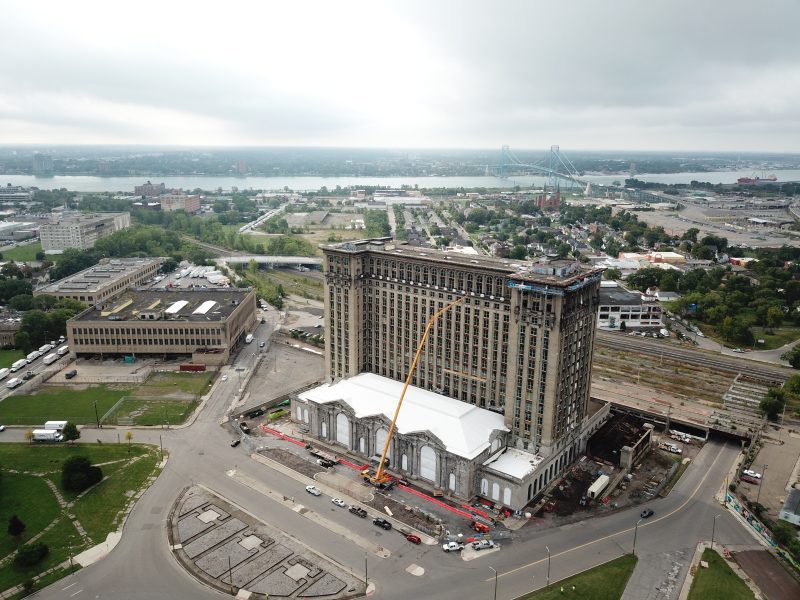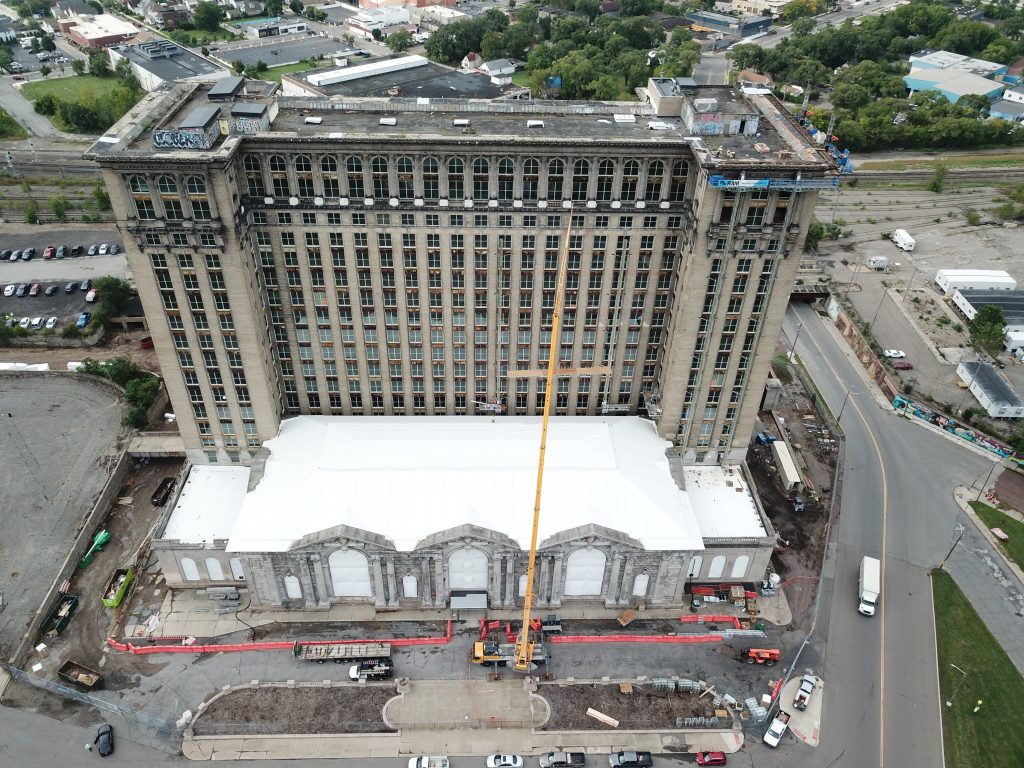Getting Michigan Central Station Back on Track: JJ Curran Crane Assists in the Rebuilding of a Grand Icon

This article originally appeared in CAM Magazine
by Mary Kremposky McArdle
Fire, glory and ruin are the first three “chapters” in the story of Detroit’s iconic Michigan Central Station:
-
- The newly built rail hub in Corktown was catapulted into operation in 1913 after a raging fire consumed the existing downtown Detroit train station the day after Christmas, according to HistoricDetroit.org.
- In its heyday, the bustling station hosted throngs of Detroit visitors, including U.S. presidents Herbert Hoover, Franklin D. Roosevelt and Harry S. Truman.
- The last train left Michigan Central Station on January 5, 1988, bound for Chicago. Once part of the City Beautiful movement in the 1900s, the grand station became the graffiti-marred symbol of Detroit’s decline.
The next chapter is part of the re-blossoming of Detroit and its historic transportation hub. After 30 years, this phoenix is finally rising from the ashes, thanks to Ford Motor Company and its decision to transform the massive 650,000-square-foot structure into the showpiece of a campus primarily devoted to autonomous and electric vehicle development, along with public spaces and other uses. Seasoned veterans of Michigan’s design and construction industry are working on the resuscitation of this National Historic Landmark, including Quinn Evans Architects, Christman-Brinker as the construction management joint venture team, RAM Construction Services as the exterior façade restoration contractor, and JJ Curran Crane Company, a 70-year-old crane rental company with deep roots in Detroit.
JJ Curran Crane: Raising Detroit’s Fortunes
As part of the revival of this long mothballed icon, JJ Curran Crane is helping to lift the fortunes of what was once the tallest train station in the world at the time of its construction. Anyone driving near Michigan Avenue and 15th Avenue in the fall of 2019 might have caught a glimpse of a Fraco mast-climber positioned at the upper reaches of the station’s 18-story tower. Working under contract to RAM Construction Services, JJ Curran operators installed the mast-climber and its support system using a 155-ton all-terrain crane. More specifically, JJ Curran and its skilled operators employed a Liebherr LTM 1130-5.1 model all-terrain crane to help set the façade restoration into motion, according to JJ Curran Crane’s Vice President of Sales and Operations Mark Wade.
RAM Project Manager and Estimator Keith B. Jewell explains the Fraco installation and its advantages: “JJ Curran Crane hoisted up large I-beams, and once those beams were attached to the building’s steel structure, the company hoisted up the large Fraco bases and set them on the I-beams.
Using JJ Curran Crane, we were able to prebuild the mast and hoist the mast sections into location, climbing up the façade in increments of 30 feet instead of five feet. This approach cut erection time immensely. Using a crane, we were able to put a game plan together that allowed us to use raised platforms in place of traditional swing stages.”
Assembled like a real-life LEGO set in action, each 30-foot mast segment was erected at a swift pace until reaching the terra cotta cornice and Juliet, or faux, balconies at the station’s 12th and 13th floors. Once installation was complete, the RAM team could remove the terra cotta pieces in all of its Beaux-Arts beauty for either replication or repair.

Heavy Lifting in the D
The Michigan Central Station resembles a building in two parts: the soaring tower rising over Roosevelt Park and a three-story, limestone-clad portion housing the grand waiting room and companion spaces of a train station designed by the same architects responsible for Grand Central Terminal in New York City. Restoration of the lower portion’s exterior façade will include work on ornate pediments over three grand arched windows, along with fluted columns and lavish capitals. “For the Waiting Room Package use of a crane is mandatory,” said Jewell, “because the limestone in this package ranges from 3,000 lbs. to 30,000 lbs. JJ Curran Crane will assist us on the disassembly and reassembly of the limestone.”
For limestone removal, JJ Curran Crane employed a 65-ton Grove Rough Terrain 765 crane with a 110-foot main boom and a 56-foot swing-away jib, according to Wade. Working on the southwest side of the building as part of the first phase, “we brought the higher-placed limestone pieces to the ground, so the pieces can either be refurbished or replaced,” said Wade. “After we remove all of the higher pieces and as we get lower, RAM will use its own smaller truck-mounted crane, or boom truck, to remove the lower pieces off of that same building section.”
JJ Curran Crane launched limestone removal on November 18, 2019, and wrapped up the first phase on December 4, 2019. JJ Curran and RAM are scheduled to resume the mission in March 2020. “Our crane will return to the site in March 2020 for nine months,” said Wade. “We will then take three months off and return the following March 2021 for another nine months.”
Over the course of the two different nine-month periods, JJ Curran Crane will work in two-week intervals. “We will work two weeks on and two weeks off for nine months before taking the winter off on the project again next year,” said Wade.
Concierge Crane Service
JJ Curran Crane offered RAM a pricing structure to manage the costs of a discontinuous work schedule. One option would have been to rent the crane as needed, but repeatedly “bringing it out to the site and bringing it back to our yard would have added to the cost,” said Wade. “Plus, the crane might not have been available when needed.
“We worked out an arrangement in which they are going to pay for the crane for nine months straight,” said Wade, “but they will only pay for the operator when the operator is actually sitting in the seat working the crane. It’s called a bare rental, and we offer customers pretty decent reduced pricing for that type of rental. This saves them a significant amount in the long run, and they are guaranteed the crane when they need it.”
JJ Curran Crane calls its method of working with its customers on cost-saving strategies concierge crane service. “We try to be like a concierge service by tailoring every job to what the customer needs,” said Wade. “When the customer is done with us, it is always our goal to have them say, ‘Wow, what a great experience that was.’”
The challenge of the actual work involved handling and removing limestone pieces widely varying in weight. According to Wade, large pieces of limestone had an average weight of 4,700 lbs. while the smallest pieces averaged 300 lbs. “We relied on the people from RAM to estimate the weights, and they have been spot on,” said Wade. “The crane was sized appropriately, and even taking their heaviest estimates, we were well within the capacity of this crane.”
A National Role Model for OSHA 1926.1427 Compliance
JJ Curran Crane operators are more than up to the task, having undergone extensive training as part of company policy. “We make sure our operators are comfortable and knowledgeable in operating a piece of equipment,” said Wade.
Crane companies now must satisfy the new OSHA regulation 1926.1427 that took effect in 2019 as well. The regulation requires every operator to be evaluated on the safe operation of each crane or piece of equipment the given operator handles in the field. JJ Curran Crane’s sister company and technology partner, Fleet Cost & Care, develops fleet management software capable of storing certification and evaluation data to help the company identify and document the equipment-handling experience of every JJ Curran Crane operator. “I think we are ahead of the curve, having started working on this system a while ago,” said Wade. “We are trying to be on the leading edge of being 100 percent compliant with this new rule.”
The company has clearly succeeded. “We can track the number of hours that each operator has in the seat of each crane,” Wade continued. “We even went through the whole process of sending three staff members to obtain training in evaluating operators. We then evaluated a hundred percent of our operators on the pieces of equipment on which they have a history. We have invested a great deal of time and effort in making sure that the operator in the seat is comfortable and knowledgeable about the crane they use on the site. That goes a long way towards safe crane operation.”
Another benefit of Fleet Cost & Care’s software is real-time documentation in the field. “Each of our operators carries a tablet with them that contains electronic job tickets,” said Wade. “The customer signs it every day to verify the operator is starting on time and they agree to all the terms and conditions. If safety regulators show up on site, our operators can use the tablet to prove that they have been evaluated on that particular piece of equipment, which is a requirement of the new regulation. Our operators can present a signed e-document from their mobile device.”
JJ Curran Crane and its sister company Fleet Cost & Care hope to share its compliance technology with their customers and other crane companies. “The software company (Fleet Cost & Care) is going back to the different companies and saying, ‘It works well at JJ Curran Crane in Detroit so Fleet Cost & Care is rolling it out across the country to show how other companies can use this software to document certification and evaluation, and stay in compliance with the new rule,” said Wade.
It’s easy to understand why RAM Construction Services sings the praises of JJ Curran Crane. “JJ Curran Crane Company has been a great asset,” said Jewell. “JJ Curran staff is very reliable. Their sales staff sends a proposal the same day or next morning. There is great communication, and the company’s operators are knowledgeable, professional, and efficient.”
Of the Michigan Central Station itself, Wade and the entire JJ Curran Crane Company are thrilled to be part of this landmark construction project intent on reviving a vintage Detroit building and creating a bold new future for Detroit. “Once complete, it will be a very special development that will also include supporting buildings,” said Wade. “The Michigan Central Station will be great for Corktown, and it will be awesome for the entire city.”